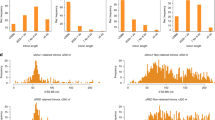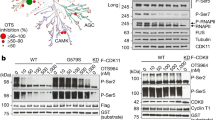Abstract
The SWI/SNF (mating-type switch/sucrose nonfermenting) complex involved in chromatin remodeling on promoters has also been detected on the coding region of genes. Here we show that SWI/SNF can function as a regulator of alternative splicing. We found that the catalytic subunit Brm favors inclusion of variant exons in the mRNA of several genes, including E-cadherin, BIM, cyclin D1 and CD44. Consistent with this, Brm associates with several components of the spliceosome and with Sam68, an ERK-activated enhancer of variant exon inclusion. Examination of the CD44 gene revealed that Brm induced accumulation of RNA polymerase II (RNAPII) with a modified CTD phosphorylation pattern on regions encoding variant exons. Altogether, our data suggest that on genes regulated by SWI/SNF, Brm contributes to the crosstalk between transcription and RNA processing by decreasing RNAPII elongation rate and facilitating recruitment of the splicing machinery to variant exons with suboptimal splice sites.
This is a preview of subscription content, access via your institution
Access options
Subscribe to this journal
Receive 12 print issues and online access
$189.00 per year
only $15.75 per issue
Buy this article
- Purchase on Springer Link
- Instant access to full article PDF
Prices may be subject to local taxes which are calculated during checkout






Similar content being viewed by others
References
Sharp, P.A. The discovery of split genes and RNA splicing. Trends Biochem. Sci. 30, 279–281 (2005).
Matlin, A.J., Clark, F. & Smith, C.W. Understanding alternative splicing: towards a cellular code. Nat. Rev. Mol. Cell Biol. 6, 386–398 (2005).
Shin, C. & Manley, J.L. Cell signalling and the control of pre-mRNA splicing. Nat. Rev. Mol. Cell Biol. 5, 727–738 (2004).
Konig, H., Ponta, H. & Herrlich, P. Coupling of signal transduction to alternative pre-mRNA splicing by a composite splice regulator. EMBO J. 17, 2904–2913 (1998).
Matter, N., Herrlich, P. & Konig, H. Signal-dependent regulation of splicing via phosphorylation of Sam68. Nature 420, 691–695 (2002).
Lukong, K.E. & Richard, S. Sam68, the KH domain-containing superSTAR. Biochim. Biophys. Acta 1653, 73–86 (2003).
Stoss, O. et al. p59(fyn)-mediated phosphorylation regulates the activity of the tissue-specific splicing factor rSLM-1. Mol. Cell. Neurosci. 27, 8–21 (2004).
Grossman, J.S. et al. The use of antibodies to the polypyrimidine tract binding protein (PTB) to analyze the protein components that assemble on alternatively spliced pre-mRNAs that use distant branch points. RNA 4, 613–625 (1998).
Kornblihtt, A.R. Promoter usage and alternative splicing. Curr. Opin. Cell Biol. 17, 262–268 (2005).
Auboeuf, D. et al. Differential recruitment of nuclear receptor coactivators may determine alternative RNA splice site choice in target genes. Proc. Natl. Acad. Sci. USA 101, 2270–2274 (2004).
Auboeuf, D., Honig, A., Berget, S.M. & O'Malley, B.W. Coordinate regulation of transcription and splicing by steroid receptor coregulators. Science 298, 416–419 (2002).
Masuhiro, Y. et al. Splicing potentiation by growth factor signals via estrogen receptor phosphorylation. Proc. Natl. Acad. Sci. USA 102, 8126–8131 (2005).
Rosonina, E., Bakowski, M.A., McCracken, S. & Blencowe, B.J. Transcriptional activators control splicing and 3′-end cleavage levels. J. Biol. Chem. 278, 43034–43040 (2003).
Martens, J.A. & Winston, F. Recent advances in understanding chromatin remodeling by Swi/Snf complexes. Curr. Opin. Genet. Dev. 13, 136–142 (2003).
Reisman, D.N. et al. Concomitant down-regulation of BRM and BRG1 in human tumor cell lines: differential effects on RB-mediated growth arrest vs CD44 expression. Oncogene 21, 1196–1207 (2002).
Kadam, S. & Emerson, B.M. Transcriptional specificity of human SWI/SNF BRG1 and BRM chromatin remodeling complexes. Mol. Cell 11, 377–389 (2003).
Marshall, T.W., Link, K.A., Petre-Draviam, C.E. & Knudsen, K.E. Differential requirement of SWI/SNF for androgen receptor activity. J. Biol. Chem. 278, 30605–30613 (2003).
Sullivan, E.K., Weirich, C.S., Guyon, J.R., Sif, S. & Kingston, R.E. Transcriptional activation domains of human heat shock factor 1 recruit human SWI/SNF. Mol. Cell. Biol. 21, 5826–5837 (2001).
Corey, L.L., Weirich, C.S., Benjamin, I.J. & Kingston, R.E. Localized recruitment of a chromatin-remodeling activity by an activator in vivo drives transcriptional elongation. Genes Dev. 17, 1392–1401 (2003).
Wilson, C.J. et al. RNA polymerase II holoenzyme contains SWI/SNF regulators involved in chromatin remodeling. Cell 84, 235–244 (1996).
Neish, A.S., Anderson, S.F., Schlegel, B.P., Wei, W. & Parvin, J.D. Factors associated with the mammalian RNA polymerase II holoenzyme. Nucleic Acids Res. 26, 847–853 (1998).
Underhill, C., Qutob, M.S., Yee, S.P. & Torchia, J. A novel nuclear receptor corepressor complex, N-CoR, contains components of the mammalian SWI/SNF complex and the corepressor KAP-1. J. Biol. Chem. 275, 40463–40470 (2000).
Dellaire, G. et al. Mammalian PRP4 kinase copurifies and interacts with components of both the U5 snRNP and the N-CoR deacetylase complexes. Mol. Cell. Biol. 22, 5141–5156 (2002).
Banine, F. et al. SWI/SNF chromatin-remodeling factors induce changes in DNA methylation to promote transcriptional activation. Cancer Res. 65, 3542–3547 (2005).
Fukudome, Y., Yanagihara, K., Takeichi, M., Ito, F. & Shibamoto, S. Characterization of a mutant E-cadherin protein encoded by a mutant gene frequently seen in diffuse-type human gastric carcinoma. Int. J. Cancer 88, 579–583 (2000).
U, M., Miyashita, T., Shikama, Y., Tadokoro, K. & Yamada, M. Molecular cloning and characterization of six novel isoforms of human Bim, a member of the proapoptotic Bcl-2 family. FEBS Lett. 509, 135–141 (2001).
Lu, F., Gladden, A.B. & Diehl, J.A. An alternatively spliced cyclin D1 isoform, cyclin D1b, is a nuclear oncogene. Cancer Res. 63, 7056–7061 (2003).
Goodison, S., Urquidi, V. & Tarin, D. CD44 cell adhesion molecules. Mol. Pathol. 52, 189–196 (1999).
Reyes, J.C. et al. Altered control of cellular proliferation in the absence of mammalian brahma (SNF2α). EMBO J. 17, 6979–6991 (1998).
Bourachot, B., Yaniv, M. & Muchardt, C. The activity of mammalian brm/SNF2α is dependent on a high-mobility- group protein I/Y-like DNA binding domain. Mol. Cell. Biol. 19, 3931–3939 (1999).
Kouskouti, A. & Talianidis, I. Histone modifications defining active genes persist after transcriptional and mitotic inactivation. EMBO J. 24, 347–357 (2005).
Jones, J.C. et al. C-terminal repeat domain kinase I phosphorylates Ser2 and Ser5 of RNA polymerase II C-terminal domain repeats. J. Biol. Chem. 279, 24957–24964 (2004).
de la Mata, M. et al. A slow RNA polymerase II affects alternative splicing in vivo. Mol. Cell 12, 525–532 (2003).
Howe, K.J., Kane, C.M. & Ares, M., Jr. Perturbation of transcription elongation influences the fidelity of internal exon inclusion in Saccharomyces cerevisiae. RNA 9, 993–1006 (2003).
Roberts, G.C., Gooding, C., Mak, H.Y., Proudfoot, N.J. & Smith, C.W. Co-transcriptional commitment to alternative splice site selection. Nucleic Acids Res. 26, 5568–5572 (1998).
Boehm, A.K., Saunders, A., Werner, J. & Lis, J.T. Transcription factor and polymerase recruitment, modification, and movement on dhsp70 in vivo in the minutes following heat shock. Mol. Cell. Biol. 23, 7628–7637 (2003).
Morris, D.P., Michelotti, G.A. & Schwinn, D.A. Evidence that phosphorylation of the RNA polymerase II carboxyl-terminal repeats is similar in yeast and humans. J. Biol. Chem. 280, 31368–31377 (2005).
Cheng, C. & Sharp, P.A. RNA polymerase II accumulation in the promoter-proximal region of the dihydrofolate reductase and γ-actin genes. Mol. Cell. Biol. 23, 1961–1967 (2003).
Cho, H. et al. A human RNA polymerase II complex containing factors that modify chromatin structure. Mol. Cell. Biol. 18, 5355–5363 (1998).
Cereghini, S. & Yaniv, M. Assembly of transfected DNA into chromatin: structural changes in the origin-promoter-enhancer region upon replication. EMBO J. 3, 1243–1253 (1984).
Soutoglou, E. & Talianidis, I. Coordination of PIC assembly and chromatin remodeling during differentiation-induced gene activation. Science 295, 1901–1904 (2002).
Agalioti, T., Chen, G. & Thanos, D. Deciphering the transcriptional histone acetylation code for a human gene. Cell 111, 381–392 (2002).
Muchardt, C., Reyes, J.C., Bourachot, B., Leguoy, E. & Yaniv, M. The hbrm and BRG-1 proteins, components of the human SNF/SWI complex, are phosphorylated and excluded from the condensed chromosomes during mitosis. EMBO J. 15, 3394–3402 (1996).
Sims, R.J., III., Belotserkovskaya, R. & Reinberg, D. Elongation by RNA polymerase II: the short and long of it. Genes Dev. 18, 2437–2468 (2004).
Trautinger, B.W., Jaktaji, R.P., Rusakova, E. & Lloyd, R.G. RNA polymerase modulators and DNA repair activities resolve conflicts between DNA replication and transcription. Mol. Cell 19, 247–258 (2005).
Bourachot, B., Yaniv, M. & Muchardt, C. Growth inhibition by the mammalian SWI-SNF subunit Brm is regulated by acetylation. EMBO J. 22, 6505–6515 (2003).
Batsché, E., Moschopoulos, P., Desroches, J., Bilodeau, S. & Drouin, J. Retinoblastoma and the related pocket protein p107 act as coactivators of NeuroD1 to enhance gene transcription. J. Biol. Chem. 280, 16088–16095 (2005).
Muchardt, C., Bourachot, B., Reyes, J.C. & Yaniv, M. ras transformation is associated with decreased expression of the brm/SNF2α ATPase from the mammalian SWI-SNF complex. EMBO J. 17, 223–231 (1998).
Muchardt, C., Sardet, C., Bourachot, B., Onufryk, C. & Yaniv, M. A human protein with homology to Saccharomyces cerevisiae SNF5 interacts with the potential helicase hbrm. Nucleic Acids Res. 23, 1127–1132 (1995).
Pfaffl, M.W. A new mathematical model for relative quantification in real-time RT-PCR. Nucleic Acids Res. 29, 2002–2007 (2001).
Acknowledgements
We thank D. Auboeuf, D. Bentley, N. Matter, H. König and B. O'Malley for the gift of plasmids and J. Seeler and J. Weitzman for critical reading of the manuscript. E.B. received a fellowship from the Ligue Nationale Contre le Cancer. The experimental work was supported by grants from the Human Frontier Science Program and Association pour la Recherche sur le Cancer.
Author information
Authors and Affiliations
Corresponding author
Ethics declarations
Competing interests
The authors declare no competing financial interests.
Supplementary information
Supplementary Figure 1
Efficiencies of the siRNA knockdowns. (PDF 344 kb)
Rights and permissions
About this article
Cite this article
Batsché, E., Yaniv, M. & Muchardt, C. The human SWI/SNF subunit Brm is a regulator of alternative splicing. Nat Struct Mol Biol 13, 22–29 (2006). https://doi.org/10.1038/nsmb1030
Received:
Accepted:
Published:
Issue Date:
DOI: https://doi.org/10.1038/nsmb1030
This article is cited by
-
MYC up-regulation confers vulnerability to dual inhibition of CDK12 and CDK13 in high-risk Group 3 medulloblastoma
Journal of Experimental & Clinical Cancer Research (2023)
-
Aberrant Cyclin D1 splicing in cancer: from molecular mechanism to therapeutic modulation
Cell Death & Disease (2023)
-
Splicing is an alternate oncogenic pathway activation mechanism in glioma
Nature Communications (2022)
-
The SWI/SNF subunit BRG1 affects alternative splicing by changing RNA binding factor interactions with nascent RNA
Molecular Genetics and Genomics (2022)
-
Splicing-associated chromatin signatures: a combinatorial and position-dependent role for histone marks in splicing definition
Nature Communications (2021)



